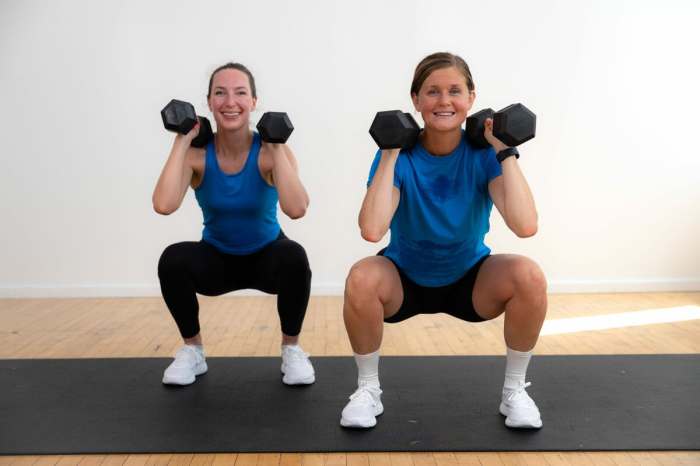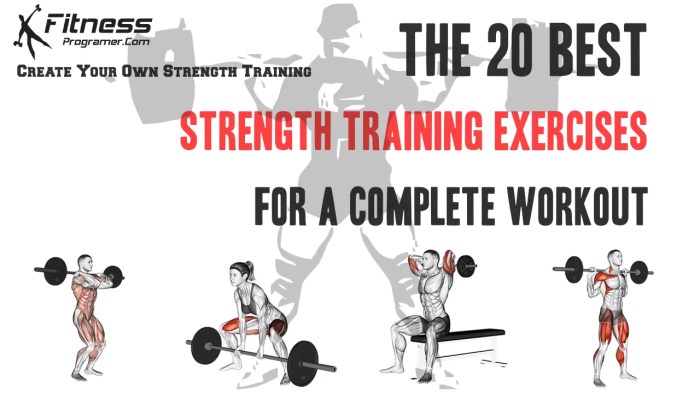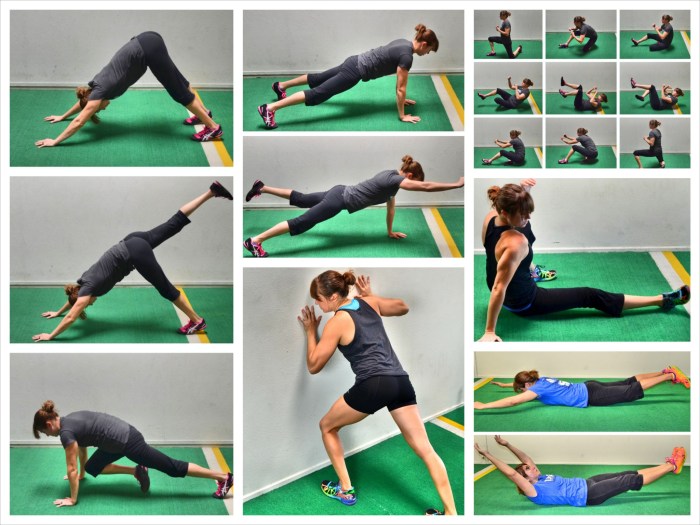Embark on a transformative journey with the best strength exercises, designed to sculpt your physique, elevate your fitness, and empower you with newfound strength. From beginners seeking to ignite their fitness flame to seasoned athletes striving for peak performance, this guide unveils the secrets to unlocking your body’s potential.
Strength training transcends mere aesthetics; it’s a cornerstone of overall well-being, reducing the risk of chronic diseases, boosting metabolism, and nurturing mental resilience. Discover the myriad benefits of incorporating these exercises into your routine and witness the profound impact they have on your life.
Introduction

Strength exercises are physical activities designed to improve muscular strength and endurance. Strength training involves contracting muscles against resistance, which can come from weights, machines, or even your own body weight.
Strength training is essential for overall health and fitness. It offers numerous benefits, both physical and mental, making it an integral part of a well-rounded fitness routine.
Benefits of Strength Exercises
Strength training offers a wide range of benefits, including:
- Increased muscle mass and strength:Strength exercises help build and strengthen muscles, improving overall physical strength.
- Improved bone density:Resistance training helps increase bone density, reducing the risk of osteoporosis and fractures.
- Enhanced metabolism:Strength training increases muscle mass, which boosts metabolism and helps burn calories more efficiently.
- Reduced risk of chronic diseases:Strength training has been linked to a reduced risk of chronic diseases such as heart disease, stroke, and type 2 diabetes.
- Improved balance and coordination:Strength exercises help improve balance and coordination, reducing the risk of falls and injuries.
- Enhanced mood and cognitive function:Strength training has been shown to improve mood, reduce stress, and enhance cognitive function.
Types of Strength Exercises
There are various types of strength exercises, each targeting different muscle groups and offering unique benefits. Here’s a table summarizing the main categories:
| Type | Description |
|---|---|
| Bodyweight exercises | Exercises that use your own body weight as resistance, such as push-ups, squats, and lunges. |
| Free weight exercises | Exercises that use dumbbells, barbells, or kettlebells as resistance, such as bicep curls, bench press, and deadlifts. |
| Machine exercises | Exercises that use weight machines with predetermined resistance, such as leg press, chest press, and lat pulldowns. |
How to Perform Strength Exercises
Proper form and technique are crucial for maximizing the benefits of strength training while minimizing the risk of injuries. Here’s a step-by-step guide for beginners:
- Choose appropriate weights:Start with a weight that is challenging but allows you to maintain good form.
- Warm up:Begin with 5-10 minutes of light cardio and dynamic stretching to prepare your body for the workout.
- Focus on form:Pay attention to proper body alignment and movement patterns to ensure you’re targeting the intended muscle groups.
- Control the movement:Perform exercises slowly and deliberately, focusing on the eccentric (lowering) phase of the movement.
- Rest adequately:Allow sufficient rest between sets and exercises to recover and prevent fatigue.
- Cool down:Finish your workout with 5-10 minutes of static stretching to improve flexibility and reduce muscle soreness.
Benefits of Strength Exercises
Strength exercises, often known as weightlifting or resistance training, are physical activities that require you to use your muscles against resistance to build strength and endurance. Incorporating strength exercises into your fitness routine offers numerous benefits for your overall health and well-being.
Increased Muscle Mass
One of the most apparent benefits of strength exercises is increased muscle mass. As you engage in resistance training, your muscles undergo microscopic tears, which then repair and rebuild themselves, leading to muscle growth and increased strength.
Improved Bone Density
Strength exercises also contribute to improved bone density. Weight-bearing activities, such as lifting weights, put stress on your bones, stimulating them to become stronger and denser. This is particularly important for preventing osteoporosis, a condition that weakens bones and makes them more susceptible to fractures.
Reduced Risk of Injury
Stronger muscles and bones can help reduce your risk of injury during everyday activities and sports. When your muscles are strong, they can better support your joints and protect them from damage. Additionally, strong bones are less likely to break or fracture.
Enhanced Metabolism
Strength exercises can also enhance your metabolism. Muscle tissue requires more energy to maintain than fat tissue, so building muscle mass can increase your resting metabolic rate, which means you burn more calories even when you’re not exercising.
Improved Mood
Strength exercises have been shown to improve mood and reduce symptoms of depression. Exercise in general releases endorphins, which have mood-boosting effects. Additionally, strength exercises can increase self-confidence and self-esteem, which can further contribute to improved mental well-being.
How to Design a Strength Training Program
Creating an effective strength training program is crucial for achieving your fitness goals. Here’s a step-by-step guide to help you design a program tailored to your needs:
Determine Your Goals
Start by identifying your fitness goals. Whether it’s building muscle, improving strength, or enhancing athletic performance, your goals will dictate the type of exercises and training parameters you choose.
Choose the Right Exercises
Select exercises that target the muscle groups you want to develop. Compound exercises, which work multiple muscle groups simultaneously, are often more efficient than isolation exercises, which focus on a single muscle group.
Set the Appropriate Weight and Repetitions
The weight you lift and the number of repetitions you perform will depend on your fitness level and goals. Beginners should start with a lighter weight and gradually increase it as they progress. For strength building, aim for 8-12 repetitions per set, while for muscle growth, 10-15 repetitions is ideal.
Rest and Recover
Adequate rest is essential for muscle recovery and growth. Allow 1-2 minutes of rest between sets and 2-3 minutes between exercises. Incorporate rest days into your program to prevent overtraining and promote recovery.
Common Mistakes in Strength Training
Strength training is an important part of a healthy lifestyle. It can help you build muscle, lose weight, and improve your overall health. However, there are some common mistakes that people make when strength training. These mistakes can lead to injuries, plateaus, and disappointment.
Here are 14 common mistakes to avoid when strength training:
Lifting too much weight
Lifting too much weight is one of the most common mistakes people make when strength training. This can lead to injuries, such as strains and sprains. It can also make it difficult to maintain good form, which can further increase your risk of injury.
Not using proper form
Using proper form is essential for strength training. This means using the correct technique for each exercise. Using improper form can lead to injuries, such as back pain and knee pain. It can also make it difficult to build muscle effectively.
Overtraining
Overtraining is another common mistake people make when strength training. This means working out too often or too hard. Overtraining can lead to injuries, such as fatigue and burnout. It can also make it difficult to build muscle effectively.
Not recovering properly
Recovering properly is essential for strength training. This means giving your body time to rest and rebuild after workouts. Not recovering properly can lead to injuries, such as muscle soreness and fatigue. It can also make it difficult to build muscle effectively.
Not warming up properly
Warming up before strength training is important to prepare your body for the workout. Warming up helps to increase your heart rate and blood flow, which can help to prevent injuries. It also helps to improve your range of motion, which can help you to perform exercises with better form.
Not cooling down properly
Cooling down after strength training is important to help your body recover from the workout. Cooling down helps to lower your heart rate and blood flow, which can help to prevent muscle soreness and fatigue. It also helps to improve your flexibility, which can help you to perform exercises with better form.
Not getting enough protein
Protein is essential for building muscle. If you are not getting enough protein, it will be difficult to build muscle, even if you are strength training regularly.
Not getting enough sleep
Sleep is essential for recovery. When you sleep, your body repairs itself and rebuilds muscle tissue. If you are not getting enough sleep, it will be difficult to build muscle, even if you are strength training regularly.
Not listening to your body
It is important to listen to your body when strength training. If you are feeling pain, stop the exercise and rest. Pushing yourself too hard can lead to injuries.
Not having a plan
Having a plan is important for strength training. This means knowing what exercises you are going to do, how many sets and repetitions you are going to do, and how much weight you are going to use. Having a plan will help you to stay on track and avoid overtraining.
Not being consistent
Consistency is key to success in strength training. If you are not consistent with your workouts, it will be difficult to build muscle. Aim to strength train 2-3 times per week.
Not having fun
If you are not enjoying your strength training workouts, you are less likely to stick with them. Find exercises that you enjoy and make working out a part of your lifestyle.
Not setting realistic goals
Setting realistic goals is important for strength training. If you set goals that are too ambitious, you are likely to get discouraged and give up. Start with small goals and gradually increase the difficulty as you get stronger.
Not celebrating your progress
Celebrating your progress is important for strength training. This will help you to stay motivated and keep you on track. Track your progress and reward yourself for reaching your goals.
Recovery from Strength Training

After a strength training session, your muscles need time to repair and rebuild. This process is called recovery. Adequate recovery is essential for making progress in strength training. If you don’t allow your muscles enough time to recover, you’ll be more likely to experience injuries and burnout.
Get Enough Rest
One of the most important things you can do for recovery is to get enough rest. This means getting 7-8 hours of sleep per night. When you sleep, your body releases hormones that help your muscles repair themselves. If you don’t get enough sleep, your body will not be able to produce these hormones, and your muscles will not recover as well.
Eat a Healthy Diet
Eating a healthy diet is also important for recovery. Your muscles need protein to repair themselves, so make sure to eat plenty of protein-rich foods, such as lean meat, fish, eggs, and beans. You also need to eat plenty of fruits, vegetables, and whole grains to provide your body with the vitamins and minerals it needs for recovery.
Use Massage or Foam Rolling
Massage or foam rolling can help to improve recovery by increasing blood flow to your muscles. This helps to remove waste products from your muscles and deliver nutrients to them. Massage or foam rolling can also help to reduce muscle soreness.
Strength Training for Women: Best Strength Exercises
Strength training, often associated with men, offers numerous benefits for women of all ages and fitness levels. Engaging in strength exercises helps women build lean muscle mass, improve bone density, enhance metabolic rate, and reduce the risk of chronic diseases.
Additionally, it can boost self-confidence and improve overall well-being.
Benefits of Strength Training for Women
- Increased muscle mass:Strength training stimulates muscle growth, leading to increased lean muscle mass. This not only improves physical appearance but also boosts metabolism and enhances overall strength.
- Improved bone density:Regular strength training puts stress on bones, promoting bone growth and increasing bone density. This is particularly important for women as they are more prone to osteoporosis later in life.
- Enhanced metabolic rate:Building muscle mass through strength training increases the body’s metabolic rate, meaning women burn more calories even at rest. This can aid in weight management and maintenance.
- Reduced risk of chronic diseases:Strength training has been linked to a reduced risk of chronic diseases such as heart disease, type 2 diabetes, and certain types of cancer. It helps improve blood sugar control, lower blood pressure, and reduce inflammation.
- Boosted self-confidence:Engaging in strength training can enhance self-confidence by empowering women to achieve physical goals and witness their own strength and progress.
Best Strength Exercises for Women
The best strength exercises for women are those that target multiple muscle groups and provide a full-body workout. Some recommended exercises include:
- Squats:Squats work the legs, glutes, and core.
- Lunges:Lunges target the legs and glutes.
- Push-ups:Push-ups strengthen the chest, triceps, and shoulders.
- Rows:Rows work the back, biceps, and shoulders.
- Planks:Planks engage the core and improve stability.
Safety Tips for Strength Training for Women
To ensure a safe and effective strength training experience, women should consider the following tips:
- Start gradually:Begin with a manageable weight and gradually increase the intensity as you progress.
- Use proper form:Always maintain good form to avoid injury and maximize results.
- Listen to your body:Rest when needed and avoid overexertion.
- Warm up and cool down:Warm up before each workout to prepare your muscles and cool down afterward to promote recovery.
- Choose exercises that suit your fitness level:Select exercises that are appropriate for your current fitness level and gradually challenge yourself as you improve.
Strength Training for Seniors

As we age, it’s crucial to maintain our physical strength to ensure independence and overall well-being. Strength training, specifically designed for seniors, offers numerous benefits and can significantly improve quality of life.
Engaging in regular strength training exercises can help seniors preserve muscle mass, increase bone density, enhance balance and coordination, and reduce the risk of falls. It also boosts metabolism, improves sleep quality, and elevates mood.
Best Strength Exercises for Seniors
When selecting strength exercises for seniors, it’s essential to prioritize safety and choose exercises that are low-impact and easy to perform. Some excellent options include:
- Chair squats: Sit in a chair with your feet hip-width apart, then stand up and sit back down slowly.
- Wall push-ups: Stand facing a wall, place your hands on the wall at shoulder height, and step back until your body is at a slight angle. Bend your elbows and lower your chest towards the wall, then push back up.
- Bicep curls: Hold dumbbells or resistance bands in each hand, with your elbows at your sides. Bend your elbows and curl the weights up towards your shoulders.
- Leg extensions: Sit in a chair with your feet flat on the floor. Lift your right leg straight up, keeping your knee slightly bent, then lower it back down.
- Calf raises: Stand with your feet flat on the floor, then slowly raise up onto your toes and lower back down.
Safety Tips for Strength Training for Seniors
To ensure a safe and effective strength training routine, seniors should follow these tips:
- Start slowly and gradually increase the intensity and duration of your workouts over time.
- Listen to your body and rest when you need to.
- Use proper form to avoid injuries.
- Consult with a doctor or physical therapist before starting any new exercise program.
- Stay hydrated by drinking plenty of water before, during, and after your workouts.
Strength Training for Athletes
Strength training is an essential component of any athlete’s training program. It can help improve performance, reduce the risk of injury, and enhance recovery.Strength training involves using weights or resistance to build muscle strength and power. This can be done through a variety of exercises, including compound exercises (which work multiple muscle groups at once) and isolation exercises (which work a single muscle group).
Benefits of Strength Training for Athletes
There are many benefits to strength training for athletes, including:
- Improved performance:Strength training can help athletes improve their speed, power, and agility. This can lead to better performance in a variety of sports, including running, jumping, and throwing.
- Reduced risk of injury:Strength training can help to strengthen the muscles and connective tissues around the joints, which can help to reduce the risk of injury. This is especially important for athletes who participate in high-impact sports, such as football and basketball.
- Enhanced recovery:Strength training can help athletes to recover from workouts and injuries more quickly. This is because strength training helps to increase blood flow to the muscles, which can help to reduce inflammation and promote healing.
Best Strength Exercises for Athletes
There are a variety of strength exercises that are beneficial for athletes. Some of the best exercises include:
- Compound exercises:Compound exercises work multiple muscle groups at once. These exercises are a great way to build overall strength and power. Some examples of compound exercises include squats, deadlifts, bench press, overhead press, and rows.
- Isolation exercises:Isolation exercises work a single muscle group. These exercises can be used to target specific muscle groups that need improvement. Some examples of isolation exercises include bicep curls, tricep extensions, leg extensions, and hamstring curls.
Safety Tips for Strength Training for Athletes
It is important to follow these safety tips when strength training for athletes:
- Start with a light weight and gradually increase:It is important to start with a weight that is challenging but not too heavy. As you get stronger, you can gradually increase the weight.
- Use proper form:It is important to use proper form when performing strength training exercises. This will help to prevent injury.
- Warm up before lifting weights and cool down afterward:Warming up before lifting weights will help to prepare your muscles for the workout. Cooling down afterward will help to reduce muscle soreness.
- Listen to your body and take rest days when needed:It is important to listen to your body and take rest days when needed. If you are feeling pain, stop exercising and consult with a doctor.
Sample Strength Training Program for Athletes
The following is a sample strength training program for athletes:
| Day | Exercises |
|---|---|
| Day 1 | Upper body (bench press, overhead press, rows) |
| Day 2 | Lower body (squats, deadlifts, leg extensions) |
| Day 3 | Rest |
| Day 4 | Upper body (bicep curls, tricep extensions, shoulders) |
| Day 5 | Lower body (hamstring curls, calf raises, glute bridges) |
| Day 6 | Rest |
| Day 7 | Rest |
Nutrition Tips for Athletes
It is important for athletes to eat a healthy diet to support their strength training program. Some nutrition tips for athletes include:
- Eat a healthy diet with plenty of protein, carbohydrates, and healthy fats:A healthy diet will provide the nutrients that your body needs to build and repair muscle tissue.
- Stay hydrated by drinking plenty of water:It is important to stay hydrated when strength training. Water helps to transport nutrients to your muscles and remove waste products.
- Supplement with creatine to improve performance:Creatine is a natural substance that can help to improve strength and power. It is a safe and effective supplement for athletes.
Recovery Tips for Athletes
It is important for athletes to get enough rest and recovery to support their strength training program. Some recovery tips for athletes include:
- Get enough sleep:Sleep is essential for recovery. It is important to get 7-8 hours of sleep each night.
- Use ice baths or compression therapy to reduce inflammation:Ice baths and compression therapy can help to reduce inflammation and promote recovery.
- Massage to improve circulation:Massage can help to improve circulation and promote recovery.
Strength Training for Weight Loss
Strength training is an effective form of exercise for weight loss. It helps to build muscle, which boosts metabolism and burns calories. In addition, strength training can help to improve insulin sensitivity, which can lead to better blood sugar control and reduced fat storage.
The best strength exercises for weight loss are compound exercises, which work multiple muscle groups at once. These exercises include squats, lunges, push-ups, and rows. These exercises can be performed with bodyweight, dumbbells, or barbells.
Safety Tips
When performing strength training exercises for weight loss, it is important to follow these safety tips:
- Start slowly and gradually increase the weight and intensity of your workouts.
- Use proper form to avoid injury.
- Listen to your body and stop if you experience any pain.
- Warm up before your workouts and cool down afterwards.
- Stay hydrated by drinking plenty of water before, during, and after your workouts.
Last Point

As you conclude your strength training odyssey, remember that consistency is the key to sustained success. Embrace the transformative power of these exercises, and let them ignite a lifelong passion for fitness. Embrace the journey, celebrate your progress, and revel in the newfound strength and vitality that awaits you.
Helpful Answers
What are the benefits of strength training?
Strength training offers a plethora of benefits, including increased muscle mass, enhanced bone density, reduced risk of injury, boosted metabolism, and improved mood.
How often should I perform strength training exercises?
Aim for two to three strength training sessions per week, targeting different muscle groups each session.
What is the recommended weight range for beginners?
Start with a weight that is challenging but allows you to maintain good form. Gradually increase the weight as you progress.
Leave a Reply